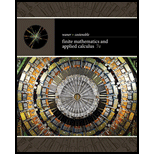
Transportation Scheduling Your publishing company is about to start a promotional blitz for its new book, Advanced Quantum Mechanics for the Liberal Arts. You have 20 salespeople stationed in Chicago and 10 in Denver. You would like to fly at most 10 salespeople into Los Angeles and at most 15 into New York. A round-trip plane flight from Chicago to Los Angeles costs $195;30 one from Chicago to New York costs $182; one from Denver to Los Angeles costs $395; and one from Denver to New York costs $166. You want to spend at most $4,520 on plane Bights. How many salespeople should you fly from each of Chicago and Denver to each of Los Angeles and New York to have the most salespeople on the road?
Trending nowThis is a popular solution!

Chapter 6 Solutions
Finite Mathematics and Applied Calculus (MindTap Course List)
- Find the equation of the tangent line to the graph of the given function at the given value of x. 6 f(x) = x(x² - 4x+5)*; x=2arrow_forwardFind the equation of the tangent line to the graph of the given function at the given value of x. f(x)=√√x+33; x=4arrow_forwardFind g[f(-7)]. f(x) = x² + 1; g(x)=-5x-1arrow_forward
- Find the x-values where the following do not have derivatives.arrow_forwardLet f(x)=7x²-2x and g(x) = 5x+3. Find f[g(k)].arrow_forwardExpress the integrand as a sum of partial fractions and evaluate the integral. 2 32s+ 32 (s²+1) (s-1)3 ds Express the integrand as a sum of partial fractions. (Simplify your answer.)arrow_forward
- Algebra & Trigonometry with Analytic GeometryAlgebraISBN:9781133382119Author:SwokowskiPublisher:Cengage
 College Algebra (MindTap Course List)AlgebraISBN:9781305652231Author:R. David Gustafson, Jeff HughesPublisher:Cengage Learning
College Algebra (MindTap Course List)AlgebraISBN:9781305652231Author:R. David Gustafson, Jeff HughesPublisher:Cengage Learning

